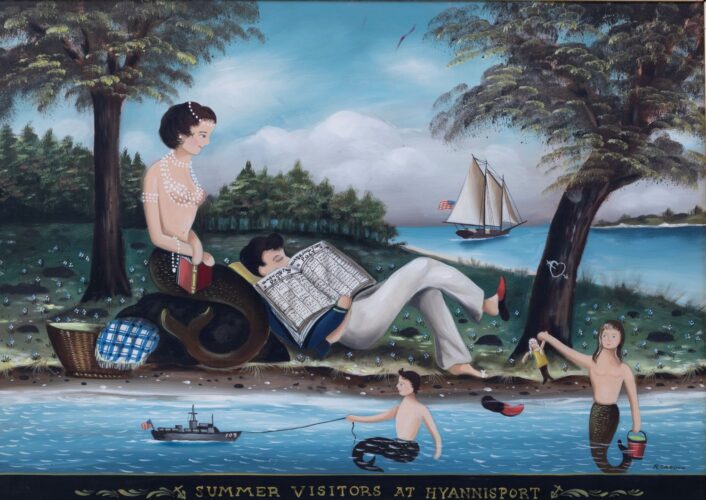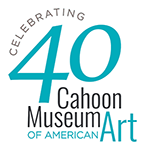
Ralph Cahoon (1910-1982)
Summer Visitors at Hyannis Port (President John F. Kennedy and Family) c. 1962
Oil on masonite
On loan from the collection of Alan Granby and Janice Hyland
Familiar Faces and Places in the Art of Ralph Cahoon
Ralph Cahoon (1910-1982) was famous for his whimsical images of sailors and mermaids cavorting in imaginary nautical scenes, but he also created artworks depicting real people and places around Cape Cod. This selection of paintings presents lively portraits of his friends, local tradespeople hard at work, an esteemed scientific locale full of animated characters, and a very famous person who once visited his studio — all interpreted in his trademark Cahoon style. The exhibition includes works from the collection of the Cahoon Museum of American Art as well as rarely seen paintings from private collections.
In the Studio with Ralph and Martha Cahoon
With twinkles in their eyes, witty personalities, and abundant talent, Ralph and Martha Cahoon embraced life together, grounded in community, family, and their love of art.
Ralph, born and raised in Chatham, and Martha, from Harwich, were quintessential Cape Codders. Themes of the seashore, sailing ships, nature, and village life abound in their paintings.
Both sophisticated and down-to-earth, they met at a local dance, married in 1932, and eventually settled into the historic Crocker House (now the Cahoon Museum) in 1945. They lovingly restored it and transformed it into their studio and gallery. They lived, painted, and sold their art amidst the aromas of home cooking and linseed oil.
Ralph and Martha began their careers as accomplished furniture decorators, but their lives took an unexpected turn in 1953 when a New York gallery owner and patron suggested they apply their talents to easel painting. Their careers took off and their work remains highly collectable today. For over 85 years, the appeal of the lighthearted exploits of Ralph’s sailors and mermaids and the delicate pastoral scenes painted by Martha has not diminished. Deeply rooted in American folk art traditions, the Cahoons’ work invokes nostalgia for a life full of lighthearted good humor, simple charm, and popular pastimes.
If interested in the Cahoon Museum’s Collection, view The Collection page.





